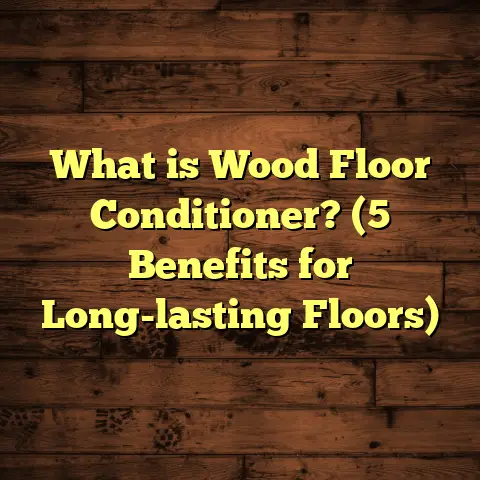What is Floor Joists and Footings? (5 Key Facts You Need!)
Spring is in full swing, and if you’re thinking about home improvement projects, your foundation and floor structure might be on your mind. After all, the floors beneath your feet hold the entire house, literally. I’ve spent years working with floor joists and footings, and I can tell you that understanding these components is like knowing the roots of a tree — they may be out of sight, but they’re what keep everything standing strong.
What Are Floor Joists and Footings?
Let’s start with the basics: what exactly are floor joists and footings?
Floor joists are the horizontal wooden or steel beams that support your floor. Imagine them as the skeleton underneath your floorboards, running parallel to one another and carrying the weight of everything on top — furniture, people, appliances — you name it. They’re typically spaced evenly, often 16 or 24 inches apart, depending on the building code and the load they need to carry.
Footings, on the other hand, are part of your foundation. They are concrete bases that sit below ground level to distribute the weight of your house evenly into the soil. Think of footings as the solid ground that holds up the entire structure, preventing settling or shifting.
Both work together to create a stable and safe floor system. Without strong joists and properly constructed footings, your floors could sag, creak, or worse — cause structural damage.
1. The Technical Side of Floor Joists: Materials and Specifications
When I first got into flooring contracts, I was surprised by how much engineering goes into selecting the right joists. You don’t just pick any piece of wood and hope for the best.
Wood vs Steel Joists
Most residential homes use wood joists, typically made from softwoods like pine or fir. These woods are popular because they’re strong yet flexible, cost-effective, and easy to work with. The standard dimensions for wood joists are usually 2×8, 2×10, or 2×12 inches, but this varies based on factors like span length (how far they stretch between supports) and load requirements.
Steel joists, while less common in homes, are more frequent in commercial buildings or modern designs where longer spans without support columns are desired. Steel joists come in open web or solid beam forms and offer higher strength-to-weight ratios.
Span Tables and Load Considerations
You’ve probably heard about span tables if you’ve ever peeked at construction plans. These tables tell you how far a joist can safely span based on its size, species, grade of lumber, and expected load (dead load + live load). For example:
- A #2 grade Douglas fir 2×10 joist can span about 15 feet with a live load of 40 pounds per square foot (psf) and a dead load of 10 psf.
- If you increase the joist size to 2×12 or switch to a higher grade wood, you can span even farther.
In my experience, careful attention to these details prevents sagging floors and costly repairs down the line.
Manufacturing Process of Engineered Joists
You might be curious about engineered joists — those manufactured wood products like I-joists or laminated veneer lumber (LVL). They’re designed for consistency and strength.
- I-joists have top and bottom flanges made of solid wood or LVL.
- The web (middle section) is usually made from oriented strand board (OSB).
They are fabricated using adhesives and pressed under heat to form tight bonds. This process reduces defects like knots and warping common in solid sawn lumber. I’ve used engineered joists on several jobs where longer spans were needed without increasing depth, making them ideal for basements or open floor plans.
2. Footings: The Foundation’s Unsung Hero
The footing is often overlooked because it’s buried underground. But I’ve learned that ignoring footings is a mistake you pay for later.
What Makes a Good Footing?
A footing must be wide and deep enough to spread the building’s weight across stable soil. The size depends on soil bearing capacity — a measure of how much weight per square foot the soil can hold without shifting.
For example:
- Sandy soil might support 1,500 psf.
- Clay soil might handle only 1,000 psf.
Local building codes typically specify minimum footing dimensions — often at least 12 inches thick and twice as wide as the foundation wall it supports.
Concrete Mix and Reinforcement
Good footings are made from concrete mixed with precise ratios of cement, sand, gravel, and water to achieve strength (usually 3,000 psi or higher). Reinforcing with steel rebar adds tensile strength to resist cracking under pressure.
I remember one project where poor footing design led to uneven settling — floors tilted noticeably after just two years. After rebuilding with proper reinforcement and soil compaction, the house stabilized perfectly.
3. How Floor Joists and Footings Work Together
You might ask: how do these two parts interact?
The footings transfer the weight into the ground; floor joists distribute weight across supports connected to these foundations. If either component fails or is improperly sized, you get problems like bouncy floors or cracks in walls.
An important detail I always check during inspections is the connection between joists and beams resting on footings. Metal hangers or ledger boards must be properly installed to keep everything locked in place.
4. Common Problems & How To Avoid Them
Over time, floor joists and footings can face issues:
- Rot & insect damage: Wood joists exposed to moisture can rot or get infested by termites.
- Sagging floors: Caused by undersized or damaged joists.
- Cracked foundations: Sometimes due to poor soil compaction or inadequate footings.
- Improper spacing: Can lead to weak floors or excessive bounce.
To avoid these problems:
- Use pressure-treated lumber for joists near moisture.
- Ensure proper drainage around your foundation.
- Follow local building codes for footing size and depth.
- Inspect regularly for signs of wear or damage.
I’ve seen many homeowners save thousands by catching issues early through routine checks.
5. Real-Life Case Study: Fixing a Sagging Floor
Here’s a story from my work that illustrates why understanding these concepts matters.
A client called me about a second-floor bedroom with a noticeable dip in the middle. After inspection, I found that original floor joists were undersized for the span and had begun to bend under load. The footings were fine but didn’t help because the joists weren’t supporting the weight correctly.
We replaced the old joists with engineered I-joists sized for their span and installed sister joists alongside where extra strength was needed. Additionally, we added new blocking between joists for stability.
The floor became rock solid again — no more creaks or dips. The client was relieved because this fix also prevented damage to drywall and flooring above.
Stretching Your Knowledge: More Details About Floor Joists
Okay, so we’ve covered basics and technical specs, but what about some deeper insights? Sometimes knowing a bit more about how these components behave helps when you want to troubleshoot or plan ahead.
Joist Spacing: Why It Matters
Ever wonder why joists are spaced at 16 inches on center (OC) or sometimes 24 inches OC? The spacing affects how much weight your floor can hold without bending too much.
- At 16 inches OC spacing, floors tend to feel more solid.
- At 24 inches OC spacing, you save material costs but might need thicker subflooring to compensate.
In my experience working with clients renovating older homes, many had floors with wider spacing than modern codes recommend. When they replaced subfloors with thinner plywood during remodels, creaking and sagging became an issue—because the floor wasn’t stiff enough between widely spaced joists.
Joist Depth & Strength Relationship
Depth is critical for strength. The deeper a joist is (the vertical height), the more load it can bear over a longer span without bending excessively.
For example:
- A 2×12 joist spans farther than a 2×8 at the same spacing.
- Doubling depth roughly quadruples bending strength (because bending strength is proportional to the moment of inertia).
This relationship explains why sometimes builders choose deeper joists instead of closer spacing—it’s about balancing material cost with performance needs.
Understanding Footing Types & Soil Interaction
While most people think of footings as simple concrete blocks underground, there’s more variety depending on soil conditions and building design.
Spread Footings vs Pile Foundations
- Spread footings are what you usually find in typical houses — wide bases spreading out weight over soil.
- Pile foundations are long columns driven deep into weak soils until they reach solid ground below (bedrock or dense soil). These piles support heavy loads where surface soils aren’t reliable.
I once worked on a coastal home where sandy soil required piles instead of traditional spread footings. It was fascinating watching massive steel piles being driven deep before pouring concrete caps on top.
Soil Testing & Bearing Capacity
Before laying footings, soil tests determine how much weight it can hold safely. This involves digging test pits or using special equipment like penetrometers.
If soil has low bearing capacity (like clayey or loose sandy soils), engineers recommend bigger footings or soil stabilization methods (compaction or chemical treatment).
When I consult on projects in areas with varying soil types, these tests save headaches later—like uneven settling or foundation cracks.
My Take on Using Engineered Wood Products for Joists
Engineered wood products have changed how we build floors today. Here’s what I’ve noticed over years using them:
Advantages I’ve Seen Firsthand:
- Consistent quality—no knots or warping like natural lumber.
- Longer spans without needing extra beams.
- Lighter weight makes installation easier.
- Environmentally friendlier—uses smaller trees efficiently.
Downsides to Watch For:
- Price tends to be higher than regular lumber.
- Requires special handling; OSB webs don’t tolerate water well.
- Some contractors unfamiliar with installation nuances cause mistakes (like improper cutting).
If you’re considering using engineered joists for your next project, ask your contractor about their experience. I always recommend professionals trained specifically in these systems because installation affects performance hugely.
What Happens When Joists Fail?
Joist failure can be gradual or sudden but always costly if ignored.
Signs of Trouble:
- Sagging floors.
- Cracks in drywall near floor level.
- Floors that bounce noticeably.
- Creaking sounds when walking.
Causes:
- Water damage leading to rot.
- Termite infestation.
- Overloading beyond design limits.
- Improper installation—wrong size or spacing.
I once had a call from a homeowner worried about noisy floors after installing heavy kitchen appliances above an older subfloor. Inspection revealed undersized joists not designed for that load; we reinforced them with sistering plus blocking—a fix that restored stability quickly.
Footing Maintenance Tips I Recommend
Footings don’t need much attention once installed well but here are some tips based on experience:
- Keep water away from foundation edges by grading land properly.
- Maintain gutters and downspouts to prevent water pooling near footings.
- Check basement floors regularly for cracks indicating shifting.
- Avoid planting large trees too close—roots can disturb soil under footings.
- Inspect exposed footings during remodeling for signs of cracking or spalling (surface breaking).
Taking care of these small details prolongs your foundation’s life significantly.
How Building Codes Guide Joist & Footing Design
Every region has building codes dictating minimum standards for safety and durability.
For example:
- International Residential Code (IRC) covers residential floor systems including joist size, spacing, allowable spans.
- Local amendments adjust based on climate (e.g., snow loads), seismic zones, soil types.
I remember one job in a snowy area where heavier snow required larger joists than usual—this knowledge steered design choices early on so post-build inspections went smoothly.
Checking codes early saves time and money by preventing rework after inspections fail.
Budgeting Your Flooring Project: Where Joists & Footings Fit In
If you’re budgeting for a new build or remodel involving floors:
- Joist lumber costs vary depending on species and size; engineered products cost more upfront but reduce labor time.
- Concrete footings pricing depends on size, depth, reinforcement needs.
As a rough example from recent projects:
| Component | Cost Range |
|---|---|
| Wood Joists (per linear ft) | $4 – $8 |
| Engineered Joists | $7 – $12 |
| Concrete Footing (per cubic yard) | $120 – $150 |
| Rebar & Reinforcement | $0.75 – $1 per lb |
Labor can add 30%-50% depending on site conditions and complexity.
Using tools like FloorTally helps me quickly generate cost estimates tailored to local rates — handy when discussing bids with clients who want transparency upfront.
My Personal Experience Working With Floor Systems
Over the years, I’ve learned that each project teaches something new about floor joists and footings:
- One winter job involved replacing rotten sill plates supporting floor joists—working in freezing temps taught me how moisture control is critical even beneath floors.
- Another renovation had hidden termite damage eating through floor joists—reminded me always to include pest inspections before starting structural repairs.
These stories reinforce that no two jobs are exactly alike; understanding principles deeply lets me adapt solutions smartly rather than guesswork.
Questions You Might Have About Floor Joists & Footings
Q: Can I install floor joists myself?
If you have carpentry skills and follow building codes carefully, yes—but mistakes can compromise safety. I recommend consulting a pro for design and inspection at minimum.
Q: How deep should footings be?
Depends on frost line in your area—usually below freezing depth (~3-4 feet) to prevent frost heave damaging foundation.
Q: Is it okay if my floor feels bouncy?
Some bounce is normal but excessive movement suggests undersized joists or spacing issues needing evaluation.
Q: Can damaged joists be repaired instead of replaced?
Sometimes yes—adding sister joists or reinforcing with steel plates works if damage isn’t severe.
Wrapping Up My Thoughts
Getting to know floor joists and footings well helps you make smart choices whether building new or fixing old floors. They’re behind-the-scenes heroes holding everything together safely.
If your floors ever feel off or you’re planning upgrades beneath them, take time to understand these elements clearly. Reach out if you want specific advice—I’m here to share practical know-how from years working hands-on with these structures.
Spring’s perfect for inspecting foundations too—don’t wait until problems show up visibly!
Thanks for sticking through this detailed look at floor joists and footings—I hope it helps you feel confident about what holds your home steady every day beneath your feet.





